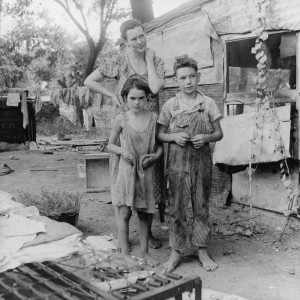
A mother and her two children eking out an existence. More than 14 million Americans were without work, had lost their homes, and seldom knew what the next meal would be at the height of the Great Depression. The New Deal attempted to put people to work in order for them to be able to provide food and shelter from their own earnings. It didn’t always work that way.
The East Texas Historical Association holds two conferences each year. The fall meeting is always held in Nacogdoches, self-proclaimed oldest city in the state. The spring meeting is held in other sites throughout East Texas. Both are always a lot of fun, a chance to visit with fellow historians, do a little networking, and hear some great papers presented on a wide array of topics.
Later this month we meet in Beaumont. Fifteen sessions are on the agenda this spring. It’s a great way for graduate students to share their research, to listen to terrific college professors and Texas authors, and to find out what a group known as Independent Scholars are researching. Three of us who fit the Independent Scholars description are presenting in the session called Physical Aspects of the New Deal in Texas.
George M. Cooper, Adjunct Professor at Lone Star College – Montgomery, began a series of New Deal lectures a few years ago. The Audie Murphy/American Cotton Museum hosted the first New Deal Conference. I presented a paper about the Beef Producers and the Agricultural Adjustment Act of 1933. This time around I will read, “Bringing Back the Building Business in Greenville, Texas.”
This paper is basically about the New Deal program known as the Public Works Administration (PWA), an agency created under the National Industrial Recovery Act (NIRA) to jumpstart construction business during the Great Depression. I cite the Greenville Municipal Auditorium (GMA) as an example of a smaller project. Larger projects included Grand Coulee Dam and LaGuardia Airport as well as aircraft carriers for the U. S. Navy.
As I began to dust off my GMA paper, I realized I needed to more about the United States in the 1930s. Yes, I knew the economic implications that led to the disaster. I heard stories from all my relatives about hard times, especially in the rural South. But what about coalminers, factory workers, those whose skills were so outdated they were unemployed? What about women, children and the elderly? What about those who lived in the north, especially on the Great Plains bordering Canada? Cold weather was definitely a factor as were floods along the Mississippi.
I read at least seven books to understand the tragedy of the time. I now have a better understanding and compassion for Americans during that time period. I admit I had been somewhat naïve in my thoughts.
While agencies such as the Works Progress Administration (WPA) is better known for “make work” to give unemployed on relief a moral and economic boost, PWA put engineers and architects, skilled carpenters, electricians, plumbers, welders, masons, and others to work. Their employment added to the general economy in addition to creating needed structures cities and states did not have tax dollars to fund. PWA projects introduced the concept of planned cities, with safe, efficient structures built to last. After all, the GMA celebrated its 75th anniversary in the fall 2014.
Fortunately, I will be able to use the same paper this summer at another New Deal Conference to be held at my alma mater, Midwestern State University in Wichita Falls. Now I’m contemplating Sam Rayburn and the New Deal. Mr. Sam was so vital to the success of the New Deal. It would be a shame not to make use of the fine Rayburn Library in Bonham to focus him.
